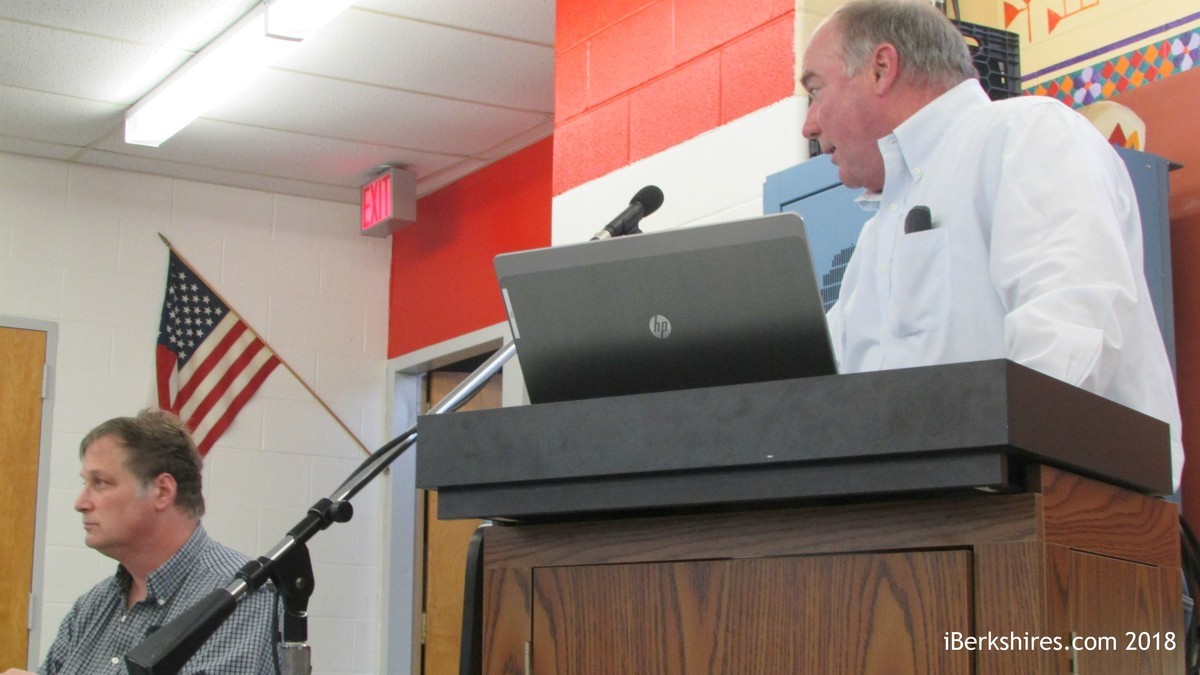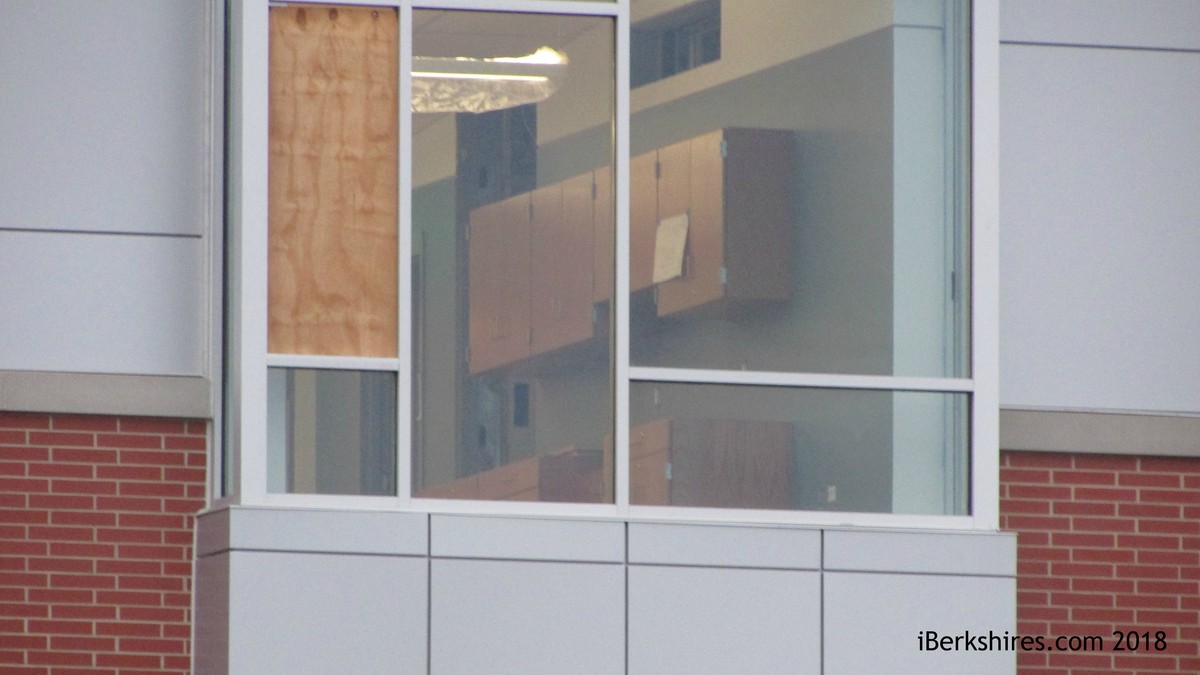Mount Greylock Building Committee Opts to Move Forward with Whiteboard InstallationBy Stephen Dravis, iBerkshires Staff
01:10AM / Friday, April 27, 2018 | |
 Mount Greylock building project owner's project manager Trip Elmore of Dore & Whittier addresses the School Building Committee as committee member Richard Cohen, left, looks on. Mount Greylock building project owner's project manager Trip Elmore of Dore & Whittier addresses the School Building Committee as committee member Richard Cohen, left, looks on. |

A third-floor academic room in the new wing, as observed on Wednesday evening from the parking lot, appears to be taking shape with cabinets installed.
WILLIAMSTOWN, Mass. — A deeply divided Mount Greylock School Building Committee on Wednesday declined to halt the installation of interactive whiteboards in order to give the district time to explore replacements.
Committee member Richard Cohen, who brought the issue to the committee's attention at its April 10 meeting, moved to direct the construction manager to stop taking delivery on whiteboards that he argued were inferior, keep any that are on the job site in their boxes and, instead, study whether the district should acquire boards that are both larger in display area and capable of allowing touch manipulation of images.
That motion failed on a vote of 4-4, with Cohen joined by Steven Wentworth, Jesse Wirtes and Al Terranova. Hugh Daley, Mark Schiek, Paula Consolini and Principal Mary MacDonald, a voting member of the committee, voted against the change.
The committee was under the gun from a time perspective in a couple of different ways.
Chairman Schiek was dealing with a bare minimum quorum of the 15-person panel, and co-chair Consolini announced at the outset of the 5:45 special meeting that she needed to leave a little before 7 p.m. in order to make a commitment for work.
She ended up staying closer to 7:30 in order to make sure that the committee could have a vote on the lone item on its agenda.
The other time constraint: The district already has display whiteboards on site and being installed in the new academic wing.
"Turner needs direction tonight," owner's project manager Trip Elmore said on behalf of Turner Construction, which was not represented at Wednesday's meeting. "Turner's major concern is they need to know what to do."
The next regular meeting of the committee is scheduled for May 8.
No one at Wednesday's meeting argued Cohen was wrong that the boards he is proposing are superior to the ones the district has on hand -- or in the delivery stream -- from the project's vendor.
As on April 10, the main objections to switching course midstream were twofold: added cost and potential delay to a $64 million project already behind in its original goal of having classes in the new academic wing this month.
On the timing issue, Cohen came armed with testimony from Valley Communications Systems, the vendor that sold the district its ceiling-mounted projectors, that the "better" whiteboards could be installed on the project's timeline.
While the current plan of holding classes in the new academic wing at the start of the 2018-19 school year is still viable, Daley argued that any change at this point could be problematic for the district.
"Revisiting this decision at this time … we are giving the [construction] team an out to say, 'The schedule is not going to hit because you did X,' " Daley said. "We need to keep all the responsibility for the schedule on the project team and the design team. We need to be the consistent one so we can hold them to account."
As for cost, the committee heard Wednesday that it likely would be in the neighborhood of $100,000. While the project still has funds in its owner's contingency line item to cover that cost, those contingency funds have already been hit several times, including, most recently, by the district's decision to rebuild the middle-high school's parking lot as part of the building project.
While the whiteboards originally included in the scope of the project (and, in some cases, in the classrooms) are eligible for some reimbursement from the Massachusetts School Building Authority, new boards ordered at this late date would not, Elmore told the committee. The cost of the change would be borne entirely by the district.
The new whiteboards, which cost about $1,800 per unit according to information supplied by Cohen's working group, would be offset by a credit of $219 per unit for old whiteboards returned at this point in the project. MacDonald reported that the school has 44 of the boards in educational spaces.
Cohen argued that the additional expense is worthwhile.
His argument on April 10 focused mostly on the touch interactivity, which is more useful with some applications, based on Cohen's conversation with Mount Greylock math teacher Karl Belouin, who served on the working group and provided more than two pages written testimony as part of its report.
On Wednesday, he argued more that the "touch-capable" whiteboards (which also can be used with a stylus) are larger in display area, allowing for greater visibility for all students in the classroom.
"If we resolve the image issue by putting compatibility-sized, 100-inch whiteboards, you'd automatically be resolving touch," Cohen said. "Touch would be a freebie."
Much of Belouin's comment was focused on the size issue.
"Screen size is extremely important," the math teacher wrote. "The larger the screen size, the greater the amount of material that can be placed on the individual pages, allowing for a more traditional and natural use of the board typical of the traditional write-only board.
"Projected images and applications (math interactive applets and applications) are harder to see and manipulate in this reduced environment, and zooming in on the application or image requires manipulation of the image that wasn't necessary when the image size was greater with the prior projection system."
Cohen noted a couple of times that the new display whiteboards being installed provide less surface area than the screens currently in use at the "old" Mount Greylock and that reducing the area is a step backward for teachers and students.
He also showed the committee a diagram generated by British retailer CDEC that shows the 100-inch diagonal whiteboards Cohen recommends would serve students in the back of the room who would be underserved by the 80-inch boards the district is installing.
In addition to debating the merits of switching to the larger, touch-sensitive boards, Cohen used the opportunity to again assail the process by which the district purchased the boards it is installing.
Again, he argued that the School Building Committee should have had more input at the beginning about specific equipment that would be installed in the classroom.
A brief discussion of a proposed compromise on the issue allowed Cohen and Wirtes to push for more voices in the procurement process.
The school's administration suggested a middle ground of ordering nine of the larger whiteboard and installing them in targeted classrooms -- mostly rooms used by math teachers.
"The reason nine was put there was we were thinking at a base level, where could these go?" MacDonald said. "That's where that came from. That doesn't mean the nine is locked in stone."
"Who is ‘we?' " Cohen asked. "Let's do it together and not just have the administration making decisions."
Wirtes, the school's facilities supervisor, agreed.
"We're talking about priorities," Wirtes said. "It could be nine [boards]. It could be 15. … That should have been the working group's decision."
Schiek asked for but did not receive a motion to take action on the compromise suggestion after Cohen's initial motion failed, 4-4. No one made a motion to install nine or any other number of the larger whiteboards, and the meeting adjourned with the direction that Turner Construction should continue with the boards already in the budget.
At several points in the meeting, it was suggested that the school always could replace the smaller boards at some point in the future out of its regular operating budget.
"Because this would be a nonreimbursable item, the only advantage we have of paying for [the larger boards] now instead of doing it over time is that now it would be rolled into the bond," Daley said.
"What we're going to lose [by inaction Wednesday] … is the $200 credit on all the boards and the cost of installation. We're still going to eat the $100,000 in [larger board] costs either way. But [by not halting], we haven't impacted our schedule.
"I think it's worth it to proceed with the existing course to keep the team on track. If we can go through your study process now, let's do that. And if it comes back that somehow these are incredibly better, we'll step into the corrective action."
| 
 MEMBER SIGN IN
MEMBER SIGN IN
 MEMBER SIGN IN
MEMBER SIGN IN